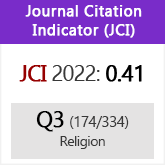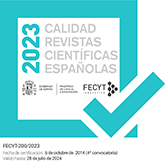Qimḥi’s Sefer ha-Shorashim: A Didactic Tool
DOI:
https://doi.org/10.3989/sefarad.016.008Keywords:
Medieval Hebrew lexicography, David Qimḥi, Ibn Janāḥ, Didactic tools, Latin Lexicography, Meaning-minimalism, Mnemonic devicesAbstract
Less than forty years after Judah ibn Tibbon translated Ibn Janāḥ’s Kitāb al-Uṣūl into Hebrew, David Qimḥi availed himself to write a new dictionary of Hebrew roots, known as Sefer ha-Shorashim. This book achieved great success and consequently overshadowed the work of his predecessor which nevertheless served as a model to Qimḥi. A preliminary research based on the roots starting by the letter ṭet and sameḵ seems to constitute a representative sample for the history of the text. First of all, it allows to better grasp Qimḥi’s motivation for writing a new dictionary. Further, the analysis of this relatively small corpus gives us clues to understand Qimḥi’s lexicological approach to the Hebrew root and his strategy in the organization of each entry.
Downloads
References
Aslanov, Cyril (2001): Le provençal des Juifs et l'hébreu en Provence: le dictionnaire Šaršot ha-kesef de Joseph Caspi (Paris).
Barney, Stephen A. et al., trans. (2006): The Etymologies of Isidore of Seville (Cambridge). https://doi.org/10.1017/CBO9780511482113
Becker, Dan (2013): "Grammatical Thought: Influence of the Medieval Arabic Grammatical Tradition," in G. Khan (ed.), Encyclopedia of Hebrew Language and Linguistics (Leiden) vol. 2, pp. 113-128.
Dhorme, Édouard (1962): La Bible, II [Paris].
Dotan, Aron (2005): The Awakening of Word Lore: From the Masora to the Beginnings of Hebrew Lexicography [Hebrew] (Jerusalem).
Eldar, Ilan (1994): "Mahalakh Shevile ha-Da'at by R. Moses Kimhi: the First Pedagogical Grammar of Hebrew," in Proceedings of the 11th World Hebrew Union, pp. 27-33.
Eldar, Ilan [1997]: "The Technique of Exemplary Paradigms used in Moses Kimhi's Grammar" [Hebrew], in M. Bar-Asher (ed.), Gideon Goldenberg Festschrift (= Massorot 9-11) pp. 203-205.
Jastrow, Marcus (1950): A Dictionary of the Targumim, the Talmud Babli and Yerushalmi, and the Midrashic Literature (New York).
Kahan, Moshe (2015): "Homonymy vs. Polysemy in Medieval Hebrew Lexicography: Between David Qimḥi's Sefer ha-Shorashim and Yonah ibn Janāḥ's Kitāb al-ʾUṣūl," Lešonenu 77:2-3-4 [in Hebrew], pp. 223-240.
Koehler, Ludwig and Walter Baumgartner (1994): The Hebrew and Aramaic Lexicon of the Old Testament (Leiden).
Kogel, Judith (2016): "La diffusion inattendue du Dictionnaire hébreu de Provence édité par Ángel Sáenz Badillos," Revue des études juives 175:1-2, pp. 47-66.
Levita, Elijah (1541): Meturgeman, ed. Paulus Fagius (Isnae [Isny]).
Marinoni, Augusto (1968): "Du glossaire au dictionnaire," Quadrivium 9, pp. 127-141.
Martínez Delgado, José (2008): "Caracterización general de la lexicografía hebrea andalusí," Revista de la Sociedad Espa-ola de Linguistica 38:2, pp. 103-128.
Martínez Delgado, José (2009): "Lexicographical Arrangement of Masoretic Material," Journal of Semitic Studies 54:2, pp. 333-363. https://doi.org/10.1093/jss/fgp002
Olszowy-Schlanger, Judith (2011): "The Science of Language among Medieval Jews," in Gad Freudenthal (ed.), Science in Medieval Jewish Cultures (New York) pp. 359-424.
Prijs, Leo (1950): Die Grammatikalische Terminologie Des Abraham Ibn Esra (Basel).
Rothschild, Jean-Pierre (2001): "Les étapes d'une appropriation : Donat ancien, Donats vernaculaires médiévaux et deux versions successives du Donat hébreu Re'shit ha-leqaḥ,ˮ Helmantica 158-159, pp. 229-274.
Sáenz-Badillos, Ángel (ed.) (1987): Un Diccionario hebreo de Provenza (Siglo XIII) (Granada).
Steiner, Richard (1998): "Saadia vs. Rashi: On the Shift from Meaning-maximalism to Meaning-minimalism in Medieval Biblical Lexicology," Jewish Quarterly Review, n.s., 88, pp. 213-258.
Talmage, Frank Ephraim (1975): David Kimhi: The Man and the Commentaries (Cambridge) p. 57.
Vidro, Nadia (2013): "The Karaite Tool-kit for Teaching Hebrew Grammar," Journal of Jewish Studies 64:1, pp. 98-118. https://doi.org/10.18647/3117/JJS-2013
Weijers, Olga [1989]: "Lexicography in the Middle Ages," Viator 20, pp. 139-153. https://doi.org/10.1484/J.VIATOR.2.301351
Weijers, Olga (1990): "Les dictionnaires et autres répertoires," in O. Weijers (ed.), Méthodes et instruments du travail intellectuel au moyen âge (Turnhout) pp. 197-208. https://doi.org/10.1484/M.CIVI-EB.4.00051
Weijers, Olga (1991): Dictionnaires et répertoires au moyen âge. Une étude du vocabulaire (Turnhout). https://doi.org/10.1484/M.CIVI-EB.5.105934
Downloads
Published
How to Cite
Issue
Section
License
Copyright (c) 2016 Consejo Superior de Investigaciones Científicas (CSIC)

This work is licensed under a Creative Commons Attribution 4.0 International License.
© CSIC. Manuscripts published in both the printed and online versions of this Journal are the property of Consejo Superior de Investigaciones Científicas, and quoting this source is a requirement for any partial or full reproduction.All contents of this electronic edition, except where otherwise noted, are distributed under a “Creative Commons Attribution 4.0 International” (CC BY 4.0) License. You may read here the basic information and the legal text of the license. The indication of the CC BY 4.0 License must be expressly stated in this way when necessary.
Self-archiving in repositories, personal webpages or similar, of any version other than the published by the Editor, is not allowed.














